In this page, I have tried to explain and put right some common misconceptions about glaciers often held by students.
Nothing lives on glaciers
Glaciers may appear lifeless, but in fact they are a rich biological hotspot. Glaciers are dusty places, and that dust is bound together with a rich and varied microbial life. This dust is called ‘cryoconite’, and it’s a mixture of dust, bits of rock and microbes.
Dust is blown onto the glacier’s surface from a variety of sources (ash, sand, soot from wildfires, deposited in rain or snowfall), and moved around on the glacier’s surface by meltwater. Glaciers are actually large storers of carbon, and they should be included in the Earth’s carbon budget.
Cryoconite is also important because it bonds the dust to the glacier’s surface, darkening the glacier. Darker glaciers absorb more energy from the sun and melt faster, so the microbial budget of a glacier is important for its mass balance.
Cryoconite often accumulates in Cryoconite Holes. This is because the dark matter absorbs more radiation, and melts downwards faster than the surrounding white, clean ice.
Read more about it in this C3W article and on Glaciers Online (and here).
Glaciers are white
Glaciers are all sorts of colours. From afar, they often look white. Close to, they can be white, blue, grey, red, green, or even black!

Glacier ice is often blue. When snow falls on glaciers, it forms layers. Older snow becomes compressed by the weight of new snow on top of it. This is called firn. Gradually, more and more snow falls on top of this firn, compressing it further. This eventually becomes glacier ice.
The crystal is changed, and glacier ice is typically crystal clear. The refractive properties of this crystal makes it appear blue.
Glaciers may be tinted red or green by algae, and spotting a green iceberg is a great pasttime on research ships in the polar regions. In contrast, rocks may fall on the surface of a glacier, making it appear black, or dark brown.
See this great video by Allen Pope to see more colours of glaciers!
Glaciers that are neither advancing nor receding are stationary
The snout (or terminus) of a glacier may be stationary, but the ice itself isn’t. The terminus of a glacier is stationary when accumulation (snow) at the top of the glacier is equal to ablation (melt) at the bottom of the glacier.
Since the top of the glacier is not getting thicker and thicker and the bottom of the glacier is not disappearing, there is transfer of mass from the top of the glacier to the bottom. When a glacier is in equilibrium like this, it still flows downslope under the force of gravity.
If accumulation at the top of the glacier is greater than ablation at the bottom, the glacier will advance, and possibly accelerate. If ablation (melting) is greater than accumulation, then the glacier will shrink. If accumulation = ablation, then the glacier’s mass balance is in equilibrium.
Retreating glaciers flow backwards.
A glacier is a pile of ice, and will always flow downwards under gravity. If more ice melts at the snout than is replenished at the top by snowfall, then the glacier will recede, or shrink – it will still flow downwards, but the snout position moves back.
I tend to avoid using ‘retreat’ as it has these connotations of ice flowing backwards. If in doubt, remember that armies retreat (turn around and run away), but hairlines recede (the hair keeps growing, but falls out at the front).
Icebergs, ice shelves, sea ice and sea level rise.
There is often confusion about the difference between these icey features. Icebergs are bits of a glacier (a tidewater glacier that ends in the ocean) that have fallen off into the sea or a lake, and floated away. This process is called calving. Most of the ablation (loss of ice) of tidewater glaciers is by iceberg calving.
Icebergs are therefore made of freshwater, and make excellent ice cubes for your gin and tonic. Icebergs are already floating, so when they melt, they do not result in sea level rise. However, if a tidewater glacier starts to calve more icebergs, and transmit more ice that used to be on the ground into the ocean, then that will result in sea level rise. Note the dirty ice in the iceberg in the photograph below.
Sea ice is frozen sea water, and is salty. The sea in polar regions, such as the Arctic Ocean and around the Antarctic continent, freezes annually in the polar winter. Sea ice floats, and when it melts, it does not contribute to sea level rise.
Ice shelves are the floating portions of glaciers. There are several very large ice shelves around Antarctica, and they are fed by a large number of glaciers. Sometimes they accrete more ice at their base by freezing sea water onto them, which can result in marine organisms sometimes turning up on the surface of the ice shelf! See our photographs of the McMurdo Ice Shelf.
Ice shelves are floating, and when they melt, or calve large icebergs, they do not directly result in sea level rise. However, ice shelves are important because they hold back the glaciers on land. When they abruptly collapse, as several have done around the Antarctic Peninsula, the glaciers flow faster and transmit more ice to the sea, resulting in sea level rise.
You can see this page at the NSIDC for more information on ice shelves.
Glaciers are bulldozers
Another common misconception is that glaciers erode by pushing rocks. In fact, the weight of the ice above causes pressure melting (ice takes up more volume than water, so it melts under pressure). You can try this yourself by weighting a cheesewire and laying it over an ice cube. It will melt through the ice cube and refreeze above it.

When a glacier encounters an obstacle (such as a boulder), the boulder inhibits the glacier’s flow by internal ice deformation. The increase in pressure results in melting water around the boulder. The water refreezes on the boulder, and ‘plucks’ it – it picks it up and carries it off.
The rougher the base of the glacier, the more pressure melting you get, and this can result in faster ice flow. Glaciers also abrade: they grind rocks against each other, making fine clays and silts. You cannot drink the meltwater that flows out of a glacier because it contains all this ‘rock flour’.
Abrasion results in smoothed, rounded surfaces, and boulders that have been glacially transported typically are faceted (they have faces or sides), rounded corners, and sometimes have scratches (striations) where they have come into contact with other rocks, and been dragged across each other.
The difference between the North and South Poles
The North Pole is in the Arctic Ocean. There is no land at the North Pole. However, the sea freezes each year, so you can walk to the pole. Arctic sea ice extent varies each year, and has been decreasing over the last 40-50 years.
The South Pole is on the Antarctic Continent, at the centre of a large ice sheet. The ice is about 3000 m thick here, and the pole itself is a flat, featureless expanse.
Both poles experience several months of darkness through their winter, but their winters are at different times – the North Pole is dark from November to about February, and the South Pole is dark from about June to September.
Penguins live in the Southern Hemisphere and polar bears live in the Northern Hemisphere.
‘The’ Ice Age

We’re still in an Ice Age. The Earth’s climate has oscillated many times over the last 2.4 million years, and this period is called the Quaternary. The Quaternary Epoch has been characterised by repeated glaciations, that sculpted and moulded the earth’s surface on numerous occasions.
We are currently in The Holocene, which started about 10,000 years ago when the last ice sheets faded away.
Quaternary glaciations are ‘paced’ by predictable and regular variations in the Earth’s orbit, with a more oblong-shaped orbit resulting in cooler summers and glacierisation.
Since the ‘Mid Pleistocene Transition’, glaciations have occurred on about a 100,000 year timescale. Before this, smaller ice sheets oscillated on a 41,000 year cycle.

Glaciers aren’t important
The polar ice caps regulate our global ocean circulation, so large ice sheets play a vital role in our climate. Small glaciers around the world are melting, and contributing to sea level rise. Glaciers world wide are important as a water resource, used for hydropower, industry, irrigation and domestic consumption. Ice shelves around Antarctica play an important role in regulating rates of ice flow.
You can read about this in more detail under Why study glaciers?
Glaciers move slowly
In fact, glaciers flow at a variety of speeds, which is controlled by a number of factors, but primarily their thermal regime. They may be wet-based or cold and dry-based, depending on the temperature of the ice, basal roughness and how thick the glacier is.
Simetimes you can get cooling glaciers under a warming climate – increased melting results in thinning, and the glacier is no longer thick enough for the ice to melt at its base. The glacier is ‘cold’ – it is dry at its base, and therefore moves very slowly and is not effective at sediment erosion or transportation.
However, some glaciers on steep slopes in temperate regions can flow very fast indeed. Fox Glacier, in New Zealand, is one of the fastest-flowing valley glaciers in the world. Fox Glacier can flow at up to 5 metres per day.
Ice Streams are responsible for most of the movement of ice in ice sheets.
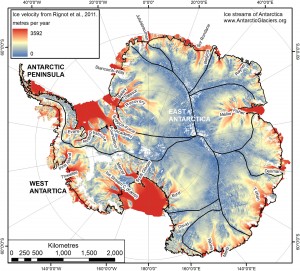
Pure, clean, crystal clear glaciers
Glaciers entrain sediment at their base, so basal ice is very dirty (see the iceberg above!). Typically, glacier basal ice has layers of frozen sand, silt and pebbles or boulders.
Secondly, debris can fall onto the surface of a glacier from the valley walls at the side or above. If there is a lot of debris falling onto the ice, it may form a rock glacier.
Glacier ice can also be clear and clean, forming large clear crystals. This glacier ice has reformed under pressure and by melting and refreezing.
Further reading
Some common misconceptions are explored further in this excellent article by Prof. Mike Hambrey.
You can also see this publication that covers misconceptions in Earth Sciences by Francek, 2013.


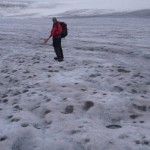
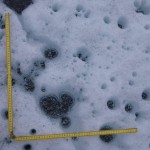




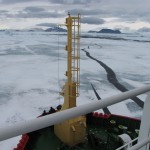


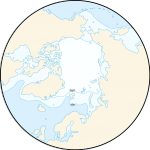
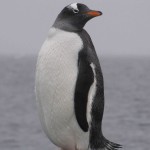

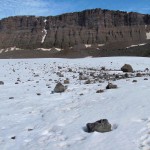

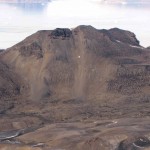
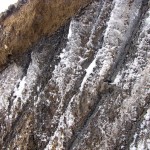
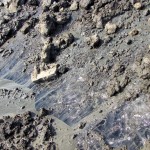
Hi Bethan, I thought you might appreciate this paper, especially Table 4. Rather unfortunately, the citations in the table are a little ambiguous as to whether the authors caused, or identified, the listed misconception . Though given the names there, I think we can make a safe guess as to which is correct. The author also states: “To date, there are no peer-reviewed journal articles on glacier misconceptions. Given the recent attention devoted to climate change and its impact on the cryosphere, this seems an opportune time for conducting research on glacier misconceptions.” So there you go.
Hope all is well in Wellington!
http://www.tandfonline.com/doi/full/10.1080/09500693.2012.736644#.UcBfUxg1Y7A
Wow, many thanks – I hadn’t seen this paper. I can see that we still have a lot to address!
Enjoyed this post and thanks for link to the great glacier colours video too.
One point I wonder about is your “We’re still in an ice age”. Given carbon dioxide levels now, the highest since the Pliocene, and the current business as usual trajectory, scientifically isn’t this point at danger of itself being a misconception?
What probability would you say there is that the bi-stable regime of ice ages and short interglacials will continue? As far as I can see, from my reading of the science, humanity’s burning of fossil fuels and land use change is decisively taking us out of an ice age, hence the talk by geologists and climate scientists of an Anthropocene. There would seem to be a very low likelihood of another ice age in the next tens of thousands of years as orbital changes reducing insolation forcing will be far outpaced by long-lasting increases in anthropogenic CO2 forcing.
Would you disagree?
Icebergs are not salty at all. The physics on how they freeze purifies the water except where they gather snow and in turn icebergs are a much more pure form of water than Glaciers. Its actually one of the miss conceptions I figured to see. Glacier ice between the dust, algae, scrubbing the earth floor, volcano residues, volcanic ash and sublimation are very dirty.comparably. Funny that some have glacier water that they claim is pure because the ice is older than man. To this day there is much more natural pollution than man made.